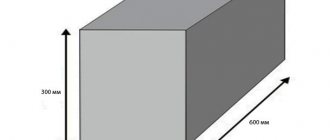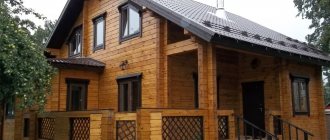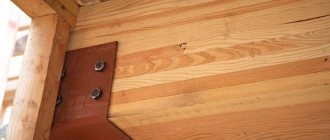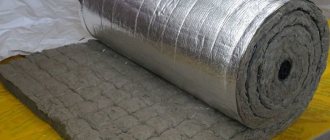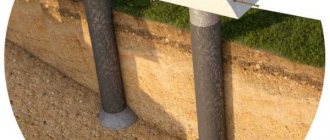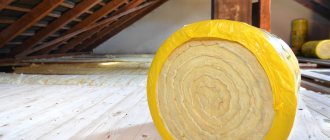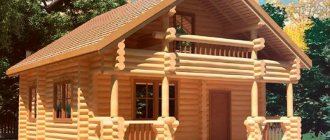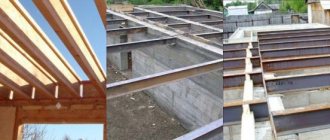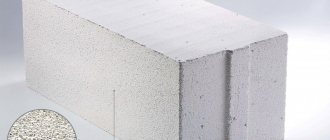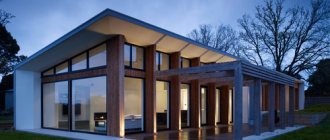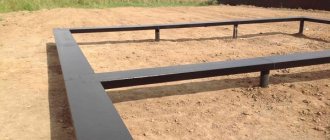You can choose any building material to build a house. Environmental friendliness, durability, accessibility - these are the main parameters that people pay attention to when choosing building materials.
Listed below are the pros and cons of a house made of foam blocks - a modern material for construction. Foam concrete blocks are larger in size than bricks, and they are light in weight. They are easy and convenient to work with, they can be easily cut with a special hacksaw. Thanks to their porosity and pliability, pipes and wiring can be hidden in the blocks. Foam blocks do not place a large load on the foundation.
Houses of up to 5 floors can be built from foam concrete. One standard foam block is the size of 15 ordinary bricks. A house made of foam blocks creates a microclimate suitable for living. The structure of the blocks allows you to maintain optimal temperature in the room. Thanks to the voids in concrete, excellent sound insulation is achieved. Foam concrete is resistant to combustion. Foam blocks are an excellent thermal insulation material - it is much warmer than brick or concrete. Foam blocks are relatively inexpensive.
Due to the large size, the consumption of glue or mortar is less than with brickwork. This is an economical material. Foreman's advice: Houses made of foam blocks are environmentally friendly. For people who care about health, foam blocks are the right choice.
efficiency; ease of processing; light weight and low load on the foundation; convenient dimensions of the blocks; environmental friendliness; noise insulation; thermal insulation and minimization of cold bridges; structural strength; resistance to external influences. Foam concrete blocks have a cellular structure, which is why this material is fragile. Due to soil movements and shrinkage of the building, cracks may appear in the foam concrete. Foam blocks absorb moisture, of course not in the same way as gas blocks, but still. If the block, like a sponge, has absorbed moisture, which freezes when cold weather sets in, it disrupts the structure of the concrete, which again causes cracks to form.
fragility; construction only in the warm season; hygroscopicity. To combat these shortcomings, it is necessary to build a house on a slab or strip foundation with a T-, L- or L-shaped profile that is resistant to soil movements and earthquakes. To reduce the influence of hygroscopicity, it is advisable to carry out construction in the dry season and be sure to do the external finishing of the walls. Foreman's advice: You can build houses from foam blocks only in the warm season, since the binding solution or special glue is not intended for low temperatures. You can purchase frost-resistant glue, but it can only be used down to -10 °C. Another disadvantage is the fact that foam blocks have been used relatively recently, which means that it is not yet possible to talk about the durability of houses made of foam blocks.
Video: comparison of foam concrete, aerated concrete and polystyrene concrete
The construction of each house begins with design, drawings, and selection of materials. The main issue is the choice of building material for the construction of the box. Everything must be calculated, the pros and cons must be weighed. You can use brick, concrete blocks, cinder blocks, foam concrete, aerated concrete, wood.
It all depends on desire and financial capabilities. Today foam concrete is very popular. This material is better known as insulation, but it is used for the construction of private houses, country houses, garages, sheds, and outbuildings.
Advantages and disadvantages
The name foam concrete speaks for itself.
Its composition is quite simple - it is liquid concrete that has been foamed. When starting construction, you need to analyze and weigh the pros and cons. Let's start with the advantages:
The advantages of this material begin with its cost. For little money you get an environmentally friendly material, it perfectly absorbs and releases moisture.
According to this indicator, it is comparable to wooden houses. Houses made of foam concrete have excellent thermal insulation. Thanks to its design with small cracks, it traps heat inside and prevents it from escaping. The sound insulation of this material is much higher than that of brick. Which makes living more comfortable. It is possible to reduce the laying time.
It is necessary to note the weight of the material, comparing with other materials, foam concrete blocks are quite light, the shape is even. Thanks to its light weight and large size, construction progresses much faster. With a simple composition, it is resistant to any temperature changes. It is not subject to combustion. Having a smooth surface, it simplifies finishing work. Working with foam concrete will bring a lot of pleasure; it can be cut with a hand saw, using a milling machine, or drilled.
You can make any shape from this material. It is easy to create different geometric shapes, for example: arches, bay windows. It is also easy to install gables under any roof.
Houses made of foam concrete must be finished with facing bricks.
Considering the advantages, it seems like an ideal material for building walls. Unfortunately, foam concrete also has disadvantages.
The first disadvantage is the decorative finishing after the walls are laid. It is advisable not to plaster all the walls; it is necessary to finish the outer walls with facing bricks. Without strong protection, foam blocks can withstand up to 20 freeze-thaw cycles.
This building material is used in low-rise construction because it has high creep. Low cottages are often built.
When purchasing foam blocks, it is necessary to control the quality of the material.
You can request a building material quality certificate. Or you can check the strength yourself: you need to drive a nail 100 mm deep into the block and then try to get it out with your bare hands; if you can’t get it out, then you can start construction. If you got it out easily, it’s better to return the foam blocks back.
A house made of foam concrete may lose qualities such as thermal insulation and sound insulation if the thickness of the masonry mortar joints exceeds 3 mm. Despite the disadvantages of this material, it is a leader in sales among building materials.
Return to contents
Differences between foam concrete and aerated concrete
Both materials belong to the same class of cellular concrete, but they differ radically in composition, technical, and operational characteristics. The production of foam concrete is simple; foaming substances are added to the concrete, poured into molds, and left to harden naturally. Foam concrete can be made at the construction site.
Aerated concrete consists of sand, lime, cement, gypsum, water, and aluminum paste.
Pores are formed as a result of the reaction. Hardening occurs under the influence of high temperature. After hardening, it is cut into blocks of the required thickness and width.
The production of aerated concrete is possible only at the factory.
In addition, almost all factories have automated production. Aerated concrete is produced in accordance with GOST, which can be confirmed by a quality certificate. Thanks to this production process, the possibility of purchasing a fake is reduced to zero.
The production of foam blocks does not require huge costs or special technologies. Its production is possible almost at home. Therefore, the chances of purchasing poor quality material are high.
You can judge the strength by the production method. If aerated concrete is produced in a factory according to standards, then in the production of foam blocks, to reduce costs, cheap analogues of foaming agents are used, which can reduce the quality of the material. Therefore, the density of aerated blocks is higher than that of foam blocks.
Thanks to the internal bubbles that do not touch, the level of thermal insulation, sound insulation, and frost resistance of foam concrete is much higher than that of aerated concrete blocks. Another advantage of foam blocks is moisture absorption. It can be used in areas with high humidity, when gas blocks need to be treated with a special, expensive, water-repellent impregnation.
Return to contents
Origin and production of foam blocks
At the end of the nineteenth century, a breakthrough was made in the field of building materials. This is due to the invention of cellular concrete. Completely environmentally friendly, durable and yet lightweight, it quickly filled a large niche in the market.
Its popularity grew so quickly that manufacturers realized that the material was worth working on. As a result of numerous experiments, several varieties of “miracle concrete” were invented (that’s what it was originally called). Actually, foam concrete is one of them.
From its progenitor - ordinary concrete - this material took a base, that is, a mixture of cement, sand and water. As a bonus, strong, fluffy foam is added to them. This is done using a special foaming agent.
In general, the production process of foam blocks is not complicated. Quite the contrary. Many people manage to assemble the same foaming agent from improvised means, and making the mixture, forming and drying the blocks is not at all difficult.
On the one hand, such ease of manufacture gives the building material a low cost, which makes it extremely desirable for budget-conscious people. On the other hand, this leads to the emergence of many handicraft industries. Most often, these are ordinary private farms that have enough space for such procedures.
Naturally, such artisanal workshops are not subject to any control. Many of us know, unfortunately, that not all private owners are responsible and decent people. Therefore, purchasing material from such farms is a lottery.
Most likely, this is why opinions on forums vary so much. Someone was unlucky with the supplier - and now he is spitting venom, telling how his foam blocks could not even be used to build a dog house. The point is that you need to choose the manufacturer extremely carefully: check its reputation, read reviews, etc.
Of course, private owners are usually cheaper. But let us remember the saying about the stingy man who pays twice. In general, contact trusted manufacturers and suppliers, and only then form your opinion about the material.
But let's return from elementary things to our topic. I propose to move on to the properties and qualities of foam concrete that make it so in demand in the modern market.
Foam concrete is the best choice for construction
If you decide to build a cottage, a garage, or need a small extension, foam concrete blocks are the best option.
This is a simple, environmentally friendly material for building walls in any home. Design and drawings of houses made of foam blocks take much less time than those made of brick or wood. Also, many companies offer ready-made foam concrete projects.
Thanks to its low weight and large dimensions, construction will move much faster. In addition, it has a number of advantages: excellent thermal insulation, sound insulation, fire resistance, high-quality foam concrete will last for many years. You will be satisfied with the house made of foam concrete.
The construction of walls made of foam concrete reduces the load on the foundation. When combined with price plus quality, foam concrete is inferior to most building materials for wall construction.
For the construction of low-rise buildings, cellular concrete blocks are widely used. This material has earned a lot of positive reviews. If you choose foam blocks, you must know the pros and cons of this porous concrete. There are nuances that affect the construction of a house made of foam blocks.
Contents:Useful tipsAdvantages of foam blocksDisadvantages of houses made of foam blocksFeatures of building a house from foam blocks
Low thermal conductivity
Cellular concrete materials (foam concrete, aerated concrete) have a unique porous structure, making them good heat insulators.
Light weight
Depending on what brand of foam concrete blocks are used, the weight is 1 cubic meter. ranges from 300 to 1200 kg. This leads to more lenient requirements for the foundation and, in practice, results in the opportunity to save on materials for the foundation of a foam block house.
Minimum hygroscopicity
In the process of producing foam concrete, a method is used to form blocks by pouring them into molds. This affects the geometry of the block, but promotes the formation of closed pores. It is thanks to this that foam concrete does not absorb moisture from the environment. A simple test, immersing foam concrete in a container of water, can demonstrate the block's resistance to water absorption.
Durability of foam concrete
This is due to the fact that concrete, which forms the basis of foam concrete, gains strength during operation. That is, the longer the house stands, the stronger the foam concrete will be.
Resistance of foam concrete to fire
In terms of fire safety class, foam concrete is one of the safest building materials, since it does not burn and does not support combustion.
Environmental friendliness of foam concrete
To make foam blocks, water, sand, cement and foaming agents are used. The latter can be of two types: natural and synthetic. Even if synthetic foaming agents are used, their specific gravity is no more than 0.5% of the total mass, which allows us to confidently declare the environmental friendliness of the material.
High speed of construction of a house from foam blocks
Installing one block is faster than laying bricks of the same square footage. Plus, the installation error will be significantly lower.
The ability to implement any architectural style
Foam concrete is easy to process. Cutting, drilling, and grinding the block is not difficult and does not require the use of special tools. Thanks to this, even a beginner with no experience in construction can remove the box of a foam block house.
Convenience of laying communications in foam concrete
Dictated by the flexibility of the blocks for processing, they are easy to groove for laying pipes, wiring, etc.
No finishing requirements
A house made of foam concrete can be used for a long time without additional finishing. As a rule, cladding is performed purely for aesthetic reasons. The most popular option is decorative plaster. A foam concrete house can be finished with any of the existing materials; it is important that they are designed for foam concrete blocks and do not have a negative impact on the microclimate in the building. Otherwise, the house’s ability to “breathe,” which is due to its porous structure, may deteriorate.
Easy to decorate
Thanks to its smooth surface, foam concrete can be plastered or finished with any other finishing material with minimal effort in preparation for finishing.
Relatively low price of foam block
Despite the fact that in absolute terms, foam concrete (35-39 rubles/piece) costs more than brick (6-10 rubles/piece). But to cover the same area, you will need one foam block (35-39 rubles/piece) and 13.5 bricks (13*6=78 rubles). The benefit is obvious. And taking into account the fact that the house does not need insulation and a strong foundation, savings can reach up to 30%.
Low cost of laying foam blocks
This aspect is relevant for those who do not plan to build a house from foam blocks with their own hands.
Useful tips
Knowledge of the features of this popular material will allow you to build a house or erect partitions without hassle. Basic Rules:
Buy foam blocks from trusted manufacturers. Pay attention to the clarity of the lines. Correct geometry is the key to quick and high-quality masonry.
If you find high-quality material with a smooth surface, buy special glue for foam blocks. Working with adhesive composition requires skill and highly qualified builders. The minimum thickness of the seam and the absence of irregularities will allow you to create monolithic masonry.
If you do not have sufficient experience in construction work and the quality of the foam blocks is average, use a good quality cement-sand mixture from well-known manufacturers. Achieve a seam thickness of up to 3 mm. A thick layer of glue or cement-sand mixture reduces the sound and heat insulation properties of foam concrete blocks.
Advantages of foam blocks
Remember! Good performance characteristics will only appear with high quality foam blocks!
There are many advantages of this type of lightweight concrete:
Reasonable cost of material.
Relatively small weight of the block - about 24 kg. The overall weight of the building and the load on the foundation will decrease. A home craftsman who does not have much experience in construction work can build a house from foam blocks.
The porous structure of foam concrete and low thermal conductivity retain heat well inside the building. In areas with a warm climate, you can refuse a layer of additional thermal insulation, provided that the masonry is of high quality. The size of foam blocks is larger than that of brick.
The work is moving much faster. The material lends itself well to processing. No expensive tools required.
Foam concrete is made from environmentally friendly components. A low percentage of impurities does not affect human health. The material helps maintain a pleasant indoor microclimate.
Even in hot weather, such a house maintains a normal temperature. Excellent sound insulation of the building is easily achieved due to the porous structure. High fire resistance.
Aesthetic qualities
The disadvantages of houses made of foam blocks include their appearance. If, for example, beautiful and high-quality brickwork can be a completed stage that does not require additional finishing, then for cottages made of foam concrete it is simply necessary to carry out facade work. And these are additional costs for the customer. After all, special substances (plaster and paint) are used for finishing, the cost of which is slightly higher than usual. Also, natural wood can be used for finishing, the price of which has never been very low.
Disadvantages of foam block houses
The relative cheapness of the production process explains some of the disadvantages of foam concrete blocks:
The geometry of the blocks is often far from ideal. Unevenness complicates the laying of walls; a thicker seam is required, which leads to the appearance of “cold bridges”.
Insufficient strength. The blocks may be damaged during transportation. Changes in the structure of the material over time, the likelihood of shrinkage inside the block.
Low bending strength. Unpresentable appearance of a building made of foam blocks. Additional finishing is required.
Foam concrete blocks
Foam concrete blocks are produced according to established technology, in various sizes, from concrete mortar of a certain grade. There is a choice both in size and properties. The main difference between foam concrete and other types of blocks is the presence of a porous structure, and from aerated concrete - closed pores (while aerated concrete has open pores and higher water absorption).
Advantages
The main advantages of the material are determined by its production technology and structure. If all standards and regulations are observed, the product is of high quality.
Among the main advantages of foam concrete, it is worth mentioning such as good strength, long service life (about 50 years), low weight (which simplifies and speeds up installation), minimal thermal conductivity, safety and environmental friendliness, and a high level of sound insulation.
It is also important that the price of the material is relatively low. It is easy and simple to work with - even a beginner can build a house on his own, without the use of special equipment and special tools, or attracting additional labor. It is possible to implement any project and design solution.
Flaws
The disadvantages of foam blocks are due to the same features as the advantages. One of the main disadvantages of the material is the large number of low-quality products on the market. Many private manufacturers use cheaper components, do not comply with production technology, offering low-quality blocks that reduce the strength characteristics of the structure and its durability.
Foam blocks can absorb water (not as much as gas blocks), so they require finishing in rooms with high humidity levels. When constructing large buildings, it must be taken into account that foam concrete does not have adequate strength and requires special reinforcement measures.
In any case, reinforcement will be needed when building a foam concrete house, since without strengthening the material will not withstand the loads.
The components in the blocks can react over a long period of time, so the material takes some time to shrink and the house is finished much later after construction is completed.
Specifications
When studying the properties of the material, maximum attention should be paid to this issue. All numbers and indicators are taken into account when making calculations and affect the properties of the future building.
Important indicators of foam concrete:
- Weight directly depends on density: a standard block measuring 20x30x60 centimeters weighs about 20 kilograms. In general, the mass is in the range of 6-24 kilograms.
- Density - indicated by the letter D, can be from D300 to
- Dimensions - the length of the block is usually 60 centimeters, the height and width may vary.
- Water absorption is within 15%.
- Ultimate compressive strength – 2-7 MPa.
- Thermal conductivity – 0.1-0.5 W/M*k.
- Sound insulation - one block 10 centimeters thick can absorb up to 40 dB.
Features of building a house from foam blocks
Before construction begins:
- study the characteristics of the material; find out the advantages and disadvantages of houses made of foam blocks.
The structure will be strong and durable if the basic rules are followed:
- houses up to three floors high are built from foam blocks; To avoid cracks, the foundation is made of a monolithic slab. A suitable option is a monolithic tape with a special recess; for the strength of the building, the walls are reinforced; cladding with decorative or ordinary bricks will improve the appearance and reduce heat loss. You will save on heating up to 20%; a ventilated façade will protect the walls from dampness and create a good microclimate inside the building.
Please note! When building a house from foam blocks, brick is often an additional material.
It is used for laying in places that bear the main atmospheric load. The main part is built from foam blocks. Be sure to carry out external finishing of the facade to protect the foam concrete from exposure to precipitation and temperature changes.
If you prefer high-quality foam blocks for construction, do not worry: more expensive building materials also have advantages and disadvantages. Foam concrete has many more advantages than disadvantages. Before purchasing, find out how to choose the “right” foam block, and then a house built from foam concrete will be strong and reliable.
Modern building materials differ significantly from their predecessors. Constant improvement leads to the fact that they become lighter, their performance improves, both strength and resistance to various aggressors, while the nominal cost decreases. Many people strive to build a house from foam blocks, the pros and cons, which are widely disputed by both professional builders and people who own such housing.
What is a foam block
Foam blocks are a material that is gradually replacing cauldrons, bricks and other natural or artificial stones. Ideally smooth edges, low weight, as well as the ability to produce foam blocks yourself make this material attractive.
To produce foam blocks, foamed concrete mortar is used, which is poured into special collapsible molds.
To obtain a cellular structure, gypsum, lime and, in some cases, aluminum powder are added to the solution. After pouring the solution into the molds, they are left alone until completely hardened. If necessary, finished foam blocks are trimmed and given a perfectly even outline.
Quite often, foam block is confused with gas block, although they have completely different production technologies and are united only by the fact that they both belong to the group of cellular materials.
Return to content
The main advantages of foam concrete over other materials
The advantages of this material are as follows:
Foam concrete is lightweight, so you don’t need to use special equipment for its transportation, as well as for loading and unloading operations. A small volume, in case of shortage, you can always buy more at any hardware store and bring it in your personal car. Light weight allows you to do without the construction of a full-fledged powerful foundation, which significantly reduces the cost of all construction as a whole. Each block has not only ideal proportions and cut angles, but also even larger dimensions compared to a standard brick or cauldron.
This significantly speeds up the process of laying walls. In addition to time, in the process of laying the walls of a house from foam blocks, costs are partially reduced, since less cement mortar is used to fasten individual elements. Smooth cuts and the presence of joining locks allow even a beginner to work with this material, getting a fairly decent result. Due to the fact that the foam block is easily processed even with improvised means, its shape can be changed to create any necessary designs.
Moreover, with a regular hacksaw you can make channels in it for hidden laying of cables and pipes. Even a low-power drill, as well as any drill, is sufficient for drilling. High environmental friendliness is due to the fact that only natural components are used in its production, the main ones of which are water, cement, sand, and gypsum. The share of additional chemical impurities in the finished product is so small that even with strong heating it does not release any harmful impurities into the room atmosphere.
That is why you can safely move into a house made of foam blocks, even with an infant, without fear for his health. The cellular structure of foam concrete blocks provides several advantages. First of all, it is low thermal conductivity, due to which the house retains heat well in winter, and in the hot season the street heat does not penetrate into it. It is very easy to maintain a microclimate in a house made of this material, which has a beneficial effect on the health of all people living in it.
In addition to thermal regulation, foam concrete cells absorb up to 85% of noise, which provides overall noise insulation of the room, which is important for buildings that somehow overlook roadways or are built in places with high background noise. Versatility of finishing work. Smooth walls do not require serious finishing work; moreover, foam concrete can be finished with almost any materials, both for internal and external work. Fire resistance. The material is practically impervious to fire, and even more so - it can withstand open flames for a long time.
Return to content
Flaws
Like any other material, foam concrete has its advantages and disadvantages. Unfortunately, it is precisely the negative qualities of foam concrete that do not allow it to completely displace other types of building materials from this group.
The cellular structure of foam concrete, which gives most of the advantages to the material, also plays a negative role, since it significantly reduces its strength.
During the process of loading, transportation and unloading, damage to individual blocks is possible, which will be expressed in chips, cracks and even breaks. A house built from foam concrete blocks must undergo a period of shrinkage for the maximum possible time. Otherwise, cracks will form along all the walls and will lead to the deterioration of the entire structure. Shrinkage and deformation inside individual blocks. This is due to the fact that cement, upon prolonged contact with carbon dioxide, releases a fairly large volume of chalk, which is not a reliable material and leads to the destruction of the block. The biggest disadvantage of foam concrete is its moisture absorption.
This material absorbs water like a dry sponge. Moreover, penetrating deep into the structure, water destroys it from the inside, and in the cold season enhances the effect of freezing of the walls. The large amount of moisture in foam concrete blocks when frozen can cause splits.
Return to content
Is it worth insulating a house made of foam concrete blocks?
Foam blocks initially do not require insulation and do not face the problem of condensation. But as the heat saving index increases, the strength level of the block decreases. The pores in the structure of the material are responsible for these characteristics - the more there are, the lower the density and strength, but the better the heat is saved. Therefore, the master has to choose and think about strengthening the loaded parts of the structure.
To insulate foam concrete, you should not use wet/ventilated facades or stone panels, the weight of which the blocks may not withstand. Preference is given to lightweight insulation without arranging heavy frames. Mineral wool and extruded polystyrene foam are best suited for these purposes.
It is best to insulate the walls of a house from the outside, since the interior decoration can cause the walls to freeze and condensation to appear.
Some tips for choosing material
To make the most of all the pros and cons of foam concrete, it is very important to choose the highest quality product.
The main problem is that, being a cheap material to produce, foam concrete is produced both in full industrial conditions, observing all technological processes, and in underground workshops, where these conditions are not met in principle. When choosing foam blocks, pay attention to the following aspects: be without visible damage, and its color is only uniform. Any incomprehensible inclusions, stains and oil stains indicate low quality products. When purchasing, it is advisable to take one block and break off a piece along its entire length. The inside structure of the material should not differ from the surface. When receiving products from a warehouse, it would be useful to pay attention to conditions for its storage. The dampness of the warehouse will be transferred to the foam blocks, and the abundance of debris from fragments of material on the floor indicates low-quality material that is destroyed even during storage. If possible, you should purchase building materials from trusted stores that can be responsible for their goods.
You can look at quality certificates from major suppliers or sellers. In addition to the correct choice of materials, high-quality construction of houses made of foam blocks also depends on compliance with construction technology. To maintain structural strength, professionals advise combining foam blocks with more durable materials. For example, columns can be laid out of brick in places of the greatest load of the structure, and also concrete belts can be used to secure the walls of the house. To reduce the risk of destruction of the walls due to shrinkage, it must be built on a slab monolithic foundation. Foam blocks can be tied to the slab using a pre-prepared belt with reinforcement, or when pouring the slab, small channels can be left along the width of the foam blocks. When laying out walls, it is recommended to use an unusual cement mortar to connect individual blocks, and a special glue, which in its qualities resembles tiles. Good cladding, as well as the use of moisture-proof materials, will help protect this material from the harmful effects of humidity and negative environmental factors. Return to content
Disadvantages of use
When choosing a building material, you should also pay attention to the disadvantages of foam concrete. The following are different:
- Sensitivity to bending. This criterion for the material is much lower than that of concrete and reinforced concrete. A higher figure can be obtained by increasing the area of a separate block, but this will reduce sound insulation.
- Variety of pore sizes. When filling porous holes with an air-entraining additive, there is no possibility of uniform filling. Therefore, the area of the foam block may differ in density.
- Shrinkage period. It takes 2-3 months after the structure is completely rebuilt. Shrinkage may increase in volume by 3-5 mm per linear meter. Occurs due to the strength gain of the material. It does not affect the external parameters of the design, but you can begin the finishing stage only after 5-6 months.
The quality and guarantee of service life of foam concrete depends on the brand and manufacturer. When purchasing building materials, you should ask the seller for quality certificates in order to protect yourself from purchasing low-grade products that are mass-produced by handicraft mini-productions. The material produced under such working conditions, as a rule, does not comply with the norms and standards approved by GOST.
